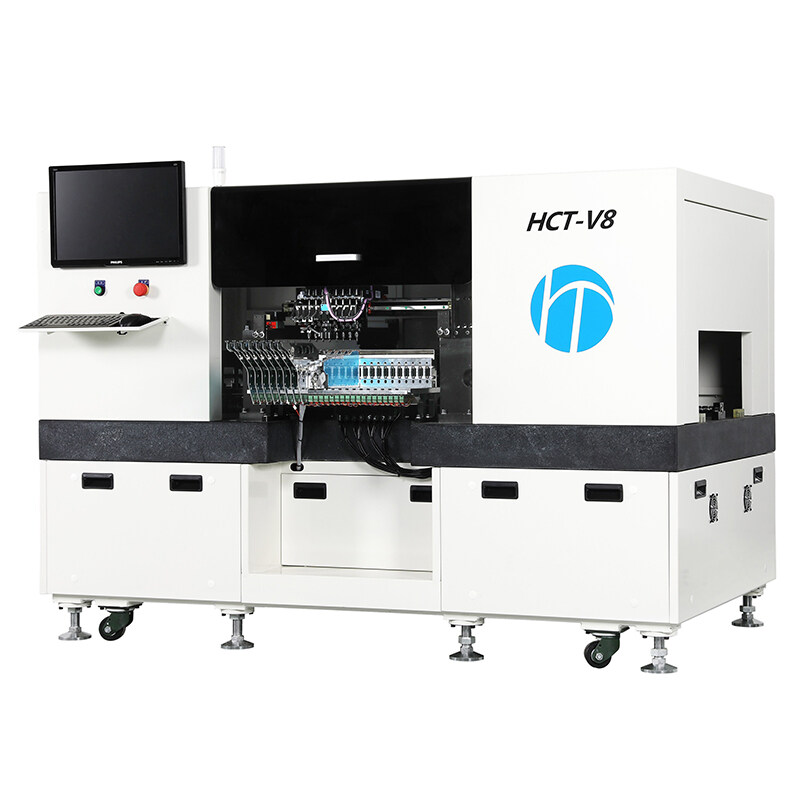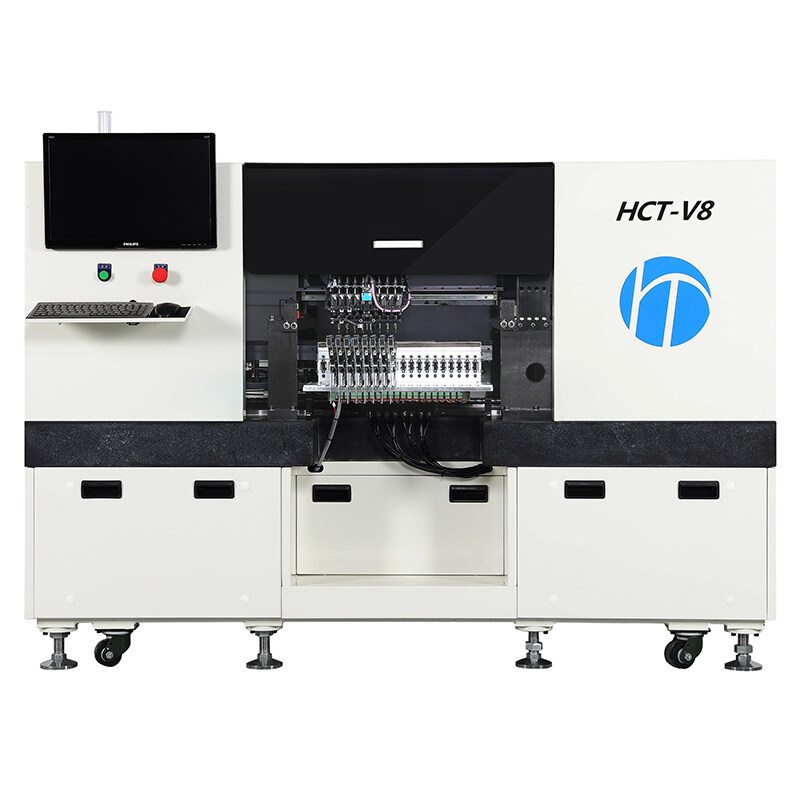Email format error
Email cannot be empty
Email already exists
6-20 characters(letters plus numbers only)
The password is inconsistent
Email format error
Email cannot be empty
Email does not exist
6-20 characters(letters plus numbers only)
The password is inconsistent


Inside Look: Exploring China's SMT Assembly Machine Components
SMT assembly machine components are essential for automating the placement of electronic components onto PCBs. In this article, we focus on exploring the key components manufactured in China, highlighting their importance in ensuring efficient production processes and high-quality output.
Understanding the Core Components:
Surface Mount Technology (SMT) assembly machines are complex systems designed to efficiently assemble electronic components onto printed circuit boards (PCBs). These machines consist of several essential components, each playing a crucial role in the assembly process:
1. Placement Head: The placement head is responsible for picking up electronic components from feeders and accurately placing them onto the PCB. It typically uses vision systems for component alignment and precision placement. The placement head's speed, accuracy, and versatility are critical for the overall efficiency of the assembly process.
2. Feeders: Feeders hold and supply electronic components to the placement head. They come in various types, including tape, stick, tray, and bulk feeders, depending on the component's size, shape, and packaging. Reliable feeders ensure a continuous supply of components, minimizing downtime and maximizing throughput.
3. Conveyor System: The conveyor system transports PCBs through various stages of the assembly process, including solder paste application, component placement, inspection, and reflow soldering. Smooth and precise movement of PCBs is essential for maintaining alignment and preventing damage to components.
4. Solder Paste Printer: The solder paste printer deposits solder paste onto the PCB pads before component placement. It ensures precise and consistent application of solder paste, which is crucial for achieving reliable solder joints during reflow soldering.
5. Reflow Oven: The reflow oven melts the solder paste, forming permanent solder joints between the components and the PCB. Temperature profiling and control are vital in the reflow process to ensure proper soldering without damaging sensitive components.
6. Inspection Systems: Inspection systems, such as automated optical inspection (AOI) and in-circuit test (ICT), verify the quality and integrity of the assembled PCBs. These systems detect defects such as missing components, misalignment, solder bridges, and insufficient solder joints, allowing for timely corrections and ensuring product quality.
7. Control System: The control system coordinates the operation of various components within the SMT assembly machine. It includes software for programming, monitoring, and optimizing the assembly process parameters, such as placement accuracy, solder paste deposition, and conveyor speed.
High-quality components are essential for the performance and longevity of SMT assembly machines for several reasons:
1. Precision and Accuracy: High-quality components ensure precise and accurate operation, leading to consistent placement accuracy, solder paste deposition, and inspection results. This reduces the risk of defects and improves overall product quality.
2. Reliability and Durability: Reliable components are less prone to failures and malfunctions, minimizing downtime and maintenance requirements. This enhances the machine's reliability and longevity, resulting in higher productivity and lower operating costs.
3. Compatibility and Integration: High-quality components are designed to work seamlessly with other machine components, ensuring compatibility and smooth operation. Integrated systems improve efficiency and reduce the complexity of assembly processes.
4. Performance Optimization: Premium components often incorporate advanced features and technologies that optimize performance, such as faster placement speeds, higher inspection accuracy, and better temperature control. These enhancements contribute to higher throughput and better quality outcomes.
Key Components Used in China's SMT Assembly Machines:
China's SMT assembly machines manufactured utilize a range of components that are commonly found in machines produced worldwide. However, certain characteristics and manufacturing processes may vary, reflecting China's industrial landscape and the priorities of manufacturers in the region. Here's an overview of key components commonly used in China's SMT assembly machines:
1. Placement Head:
- Characteristics: Chinese-made placement heads often prioritize cost-effectiveness and versatility. They may offer competitive performance in terms of speed and accuracy, with a focus on handling a wide range of component sizes and types.
- Materials and Manufacturing: These placement heads are typically constructed using durable materials such as aluminum alloys or stainless steel. Manufacturing processes may involve precision machining and assembly techniques to ensure consistent performance.
- Reliability and Durability: While reliability and durability can vary depending on the manufacturer, many Chinese-made placement heads offer satisfactory performance under normal operating conditions. However, long-term reliability may be influenced by factors such as maintenance practices and the quality of supporting components.
2. Feeders:
- Characteristics: Chinese-made feeders are designed to provide efficient and reliable component feeding while minimizing costs. They may offer various feeding mechanisms to accommodate different component packaging formats.
- Materials and Manufacturing: Feeders are typically constructed from robust materials such as plastics and metals, with an emphasis on durability and longevity. Manufacturing processes may involve injection molding or CNC machining to achieve precise tolerances.
- Reliability and Durability: Chinese-made feeders are generally reliable and durable, capable of withstanding the demands of high-volume production environments. However, occasional maintenance and calibration may be required to ensure consistent performance over time.
3. Conveyor System:
- Characteristics: Chinese-manufactured conveyor systems prioritize efficiency, flexibility, and ease of integration with other assembly line components. They may offer modular designs to accommodate different PCB sizes and production layouts.
- Materials and Manufacturing: Conveyor systems are typically constructed from sturdy materials such as aluminum or stainless steel, with an emphasis on rigidity and stability. Manufacturing processes may involve welding, machining, and assembly techniques to ensure robustness and precision.
- Reliability and Durability: Chinese-made conveyor systems are generally reliable and durable, capable of handling continuous operation in demanding production environments. Proper maintenance and periodic inspections can help ensure long-term reliability.
4. Solder Paste Printer:
- Characteristics: Chinese-made solder paste printers focus on precision, speed, and ease of operation. They may offer advanced features such as automatic stencil alignment and solder paste inspection.
- Materials and Manufacturing: Solder paste printers are typically constructed from high-quality materials such as steel and aluminum, with precise machining and assembly processes to achieve tight tolerances. Special attention may be paid to the printing mechanism and vision system components.
- Reliability and Durability: Chinese-made solder paste printers are designed to deliver reliable performance over extended periods of use. Regular maintenance and calibration are essential to ensure consistent printing quality and longevity.
5. Reflow Oven:
- Characteristics: Chinese-manufactured reflow ovens prioritize temperature control, uniform heating, and energy efficiency. They may offer various heating zones and conveyor configurations to accommodate different PCB sizes and assembly requirements.
- Materials and Manufacturing: Reflow ovens are typically constructed from high-temperature-resistant materials such as stainless steel and ceramic insulation. Manufacturing processes involve precise machining, welding, and assembly techniques to ensure thermal stability and performance.
- Reliability and Durability: Chinese-made reflow ovens are generally reliable and durable, capable of delivering consistent temperature profiles and soldering results. Proper maintenance and calibration are essential to ensure optimal performance and longevity.
Advanced Technologies and Innovations:
In recent years, China's SMT assembly machine manufacturers have been integrating various advanced technologies and innovations into their components to enhance machine performance, accuracy, and efficiency. These advancements contribute to improving production throughput, quality control, and overall productivity. Here are some examples of cutting-edge components and their impact on the functionality of SMT assembly machines:
1. Advanced Placement Heads:
- Chinese manufacturers are incorporating advanced placement heads equipped with enhanced vision systems and artificial intelligence (AI) algorithms. These systems can quickly and accurately identify components, even in complex manufacturing environments, leading to improved placement accuracy and speed.
- Placement heads with increased degrees of freedom and multi-functional capabilities enable the handling of a wider range of component types and sizes, reducing the need for manual intervention and setup changes.
2. Smart Feeders:
- Smart feeders equipped with sensors and communication capabilities are becoming increasingly prevalent in Chinese-made SMT assembly machines. These feeders can monitor component levels, detect jams or errors, and communicate with the control system to optimize feed rates and minimize downtime.
- Integration of machine learning algorithms into feeder systems allows for predictive maintenance and optimization of component loading sequences based on historical data, further enhancing overall equipment effectiveness (OEE).
3. Industry 4.0 Integration:
- Chinese manufacturers are embracing Industry 4.0 principles by integrating IoT (Internet of Things) connectivity and data analytics capabilities into SMT assembly machines. This enables real-time monitoring of machine performance, production metrics, and quality parameters.
- Cloud-based software platforms allow manufacturers to remotely access and analyze production data, identify trends, and implement continuous improvements. Predictive maintenance algorithms help anticipate and prevent equipment failures, maximizing uptime and reducing maintenance costs.
4. High-Resolution Solder Paste Printers:
- Chinese-made solder paste printers are incorporating high-resolution vision systems and advanced printing algorithms to achieve precise solder paste deposition. These systems can detect and compensate for PCB warpage, stencil alignment errors, and other factors affecting print quality.
- Integration of closed-loop feedback mechanisms enables real-time adjustments to printing parameters, ensuring consistent paste volume and distribution across the PCB, resulting in improved solder joint quality and reliability.
5. Energy-Efficient Reflow Ovens:
- Reflow ovens manufactured in China are adopting energy-efficient heating technologies, such as infrared radiation and convection heating, to reduce power consumption and minimize thermal stress on components.
- Advanced temperature profiling and control systems with multi-zone heating capabilities ensure precise temperature management during the reflow process, optimizing soldering results and minimizing defects such as tombstoning and voiding.
Quality Control and Assurance Measures:
China's SMT assembly machine manufacturers recognize the importance of quality control and assurance measures to ensure the reliability and performance of their components. To maintain competitiveness and reputation in the global market, these manufacturers implement rigorous quality control processes throughout the production process. Here's an insight into the quality control measures typically employed by Chinese manufacturers:
1. Certifications and Standards Compliance:
- Chinese manufacturers often adhere to international quality standards and certifications such as ISO 9001 for quality management systems and ISO 14001 for environmental management systems. Compliance with these standards demonstrates a commitment to quality and customer satisfaction.
- Additionally, manufacturers may obtain certifications specific to the electronics manufacturing industry, such as IPC (Association Connecting Electronics Industries) standards for PCB assembly and soldering processes.
2. Supplier Quality Management:
- Chinese manufacturers maintain stringent supplier evaluation and management processes to ensure the quality of raw materials and components used in SMT assembly machines. Suppliers are often required to meet specific quality standards and undergo regular audits and inspections.
- Establishing long-term partnerships with reputable suppliers helps maintain consistency in component quality and reliability, ultimately benefiting the overall quality of SMT assembly machines.
3. In-Process Inspection and Testing:
- Throughout the manufacturing process, Chinese manufacturers conduct in-process inspections and testing to detect and address potential quality issues early on. This may involve visual inspection, dimensional measurements, functional testing, and performance validation.
- Automated inspection equipment, such as AOI (Automated Optical Inspection) systems and X-ray inspection machines, are utilized to ensure the integrity of critical components and assemblies.
4. End-of-Line Testing and Validation:
- Prior to shipment, SMT assembly machines undergo comprehensive end-of-line testing and validation procedures to verify their performance, functionality, and reliability. This includes running production simulations, conducting stress tests, and assessing compliance with specifications and customer requirements.
- Test results are documented and reviewed to identify any deviations or anomalies, which are then addressed through corrective actions to ensure that only fully functional and compliant machines are delivered to customers.
5. Continuous Improvement Initiatives:
- Chinese manufacturers prioritize continuous improvement initiatives aimed at enhancing product quality, efficiency, and customer satisfaction. This involves analyzing feedback from customers, monitoring performance metrics, and implementing corrective and preventive actions to address any quality issues or opportunities for improvement.
- Continuous training and skill development programs for employees contribute to a culture of quality excellence and innovation within the organization.
Case Studies and Success Stories:
Here are some case studies and success stories showcasing the effectiveness of China's SMT assembly machine components:
1. Case Study: Electronics Manufacturing Company XYZ
- Background: Electronics Manufacturing Company XYZ, based in Southeast Asia, was looking to upgrade its SMT assembly line to improve efficiency and product quality.
- Solution: The company opted for SMT assembly machines equipped with advanced placement heads and smart feeders manufactured by a leading Chinese supplier.
- Results: After implementing the new machines, Company XYZ experienced a significant increase in production throughput and placement accuracy. The advanced placement heads and smart feeders enabled faster setup times, reduced downtime due to component errors, and improved overall equipment effectiveness.
- Testimonial: "We are extremely satisfied with the performance of the SMT assembly machines from our Chinese supplier. The advanced technologies and innovations integrated into the components have greatly enhanced our production efficiency and product quality. We highly recommend these machines to other electronics manufacturers looking to stay competitive in the industry."
2. Case Study: Automotive Electronics Manufacturer ABC
- Background: Automotive Electronics Manufacturer ABC, based in Europe, required high-quality SMT assembly machines to meet the stringent reliability and performance standards of the automotive industry.
- Solution: The company selected SMT assembly machines manufactured by a reputable Chinese supplier known for its commitment to quality and innovation.
- Results: The Chinese-made SMT assembly machines met and exceeded the rigorous quality and performance requirements of Automotive Electronics Manufacturer ABC. The precision placement heads, advanced solder paste printers, and energy-efficient reflow ovens contributed to the production of defect-free PCB assemblies with exceptional solder joint integrity.
- Testimonial: "We are impressed with the reliability and quality of the SMT assembly machines supplied by our Chinese partner. These machines have played a crucial role in helping us maintain our reputation for excellence in automotive electronics manufacturing. We look forward to continued collaboration and success."
3. Case Study: Consumer Electronics Company DEF
- Background: Consumer Electronics Company DEF, based in North America, needed cost-effective yet reliable SMT assembly machines to meet the high demand for its electronic products.
- Solution: DEF partnered with a Chinese manufacturer renowned for its expertise in producing high-quality SMT assembly machines at competitive prices.
- Results: The Chinese-made SMT assembly machines provided DEF with a cost-effective solution without compromising on performance or quality. The placement heads, feeders, and reflow ovens delivered consistent results, enabling DEF to meet production targets while maintaining stringent quality standards.
- Testimonial: "The SMT assembly machines from our Chinese supplier have exceeded our expectations in terms of reliability, performance, and value. These machines have been instrumental in helping us scale our production and meet the growing demand for our consumer electronics products. We are extremely satisfied with our partnership and the results achieved."
Future Trends and Developments:
The future of SMT assembly machine components in China is expected to witness significant advancements and innovations driven by emerging technologies, materials, and manufacturing processes. Here's an exploration of future trends and developments in this realm:
1. Miniaturization and High-Density Integration:
- As electronic devices continue to shrink in size and complexity, there will be a growing demand for SMT assembly machine components capable of handling smaller and more densely packed components.
- Chinese manufacturers will focus on developing placement heads with higher precision and finer resolution to accommodate miniaturized components such as 0201 and smaller chip packages.
2. Advanced Vision Systems and AI Integration:
- Future SMT assembly machine components in China will incorporate more advanced vision systems augmented by artificial intelligence (AI) and machine learning algorithms.
- AI-driven placement heads and solder paste printers will offer improved component recognition, adaptive process optimization, and self-learning capabilities, leading to higher efficiency and accuracy.
3. Smart Manufacturing and Industry 4.0 Integration:
- Chinese manufacturers will increasingly adopt smart manufacturing principles and integrate Industry 4.0 technologies into SMT assembly machine components.
- IoT-enabled sensors, data analytics, and connectivity solutions will enable real-time monitoring, predictive maintenance, and remote diagnostics, enhancing overall equipment effectiveness (OEE) and production efficiency.
4. Materials Innovation for Sustainability:
- There will be a growing emphasis on sustainability and eco-friendly materials in SMT assembly machine components manufacturing.
- Chinese manufacturers will explore the use of recycled and biodegradable materials, as well as alternative energy sources, to reduce environmental impact and comply with increasingly stringent regulations.
5. Additive Manufacturing (3D Printing):
- Additive manufacturing techniques, such as 3D printing, will play a more significant role in prototyping and production of custom SMT assembly machine components.
- Chinese manufacturers will leverage 3D printing technology to rapidly iterate designs, reduce lead times, and customize components according to specific customer requirements.
6. Advanced Materials and Coatings:
- The use of advanced materials and coatings with improved thermal conductivity, wear resistance, and corrosion protection will become more prevalent in SMT assembly machine components.
- Chinese manufacturers will invest in research and development of new materials and surface treatments to enhance component durability, reliability, and performance in demanding manufacturing environments.
7. Global Collaboration and Partnerships:
- Chinese manufacturers will increasingly collaborate with international partners and industry leaders to access cutting-edge technologies, expertise, and market opportunities.
- Strategic partnerships and joint ventures will facilitate knowledge exchange, technology transfer, and innovation, positioning China's SMT assembly machine components as competitive offerings in the global market.
Conclusion
In light of these insights, it is evident that China's SMT assembly machine components present a compelling option for manufacturers seeking reliable, high-performance solutions. As the industry continues to evolve, embracing the advancements and quality offerings from Chinese manufacturers can lead to improved productivity, efficiency, and competitiveness in manufacturing operations. It is imperative for professional machine makers to consider the value proposition offered by China-made components and explore partnerships that drive mutual growth and success in the global electronics manufacturing landscape.

